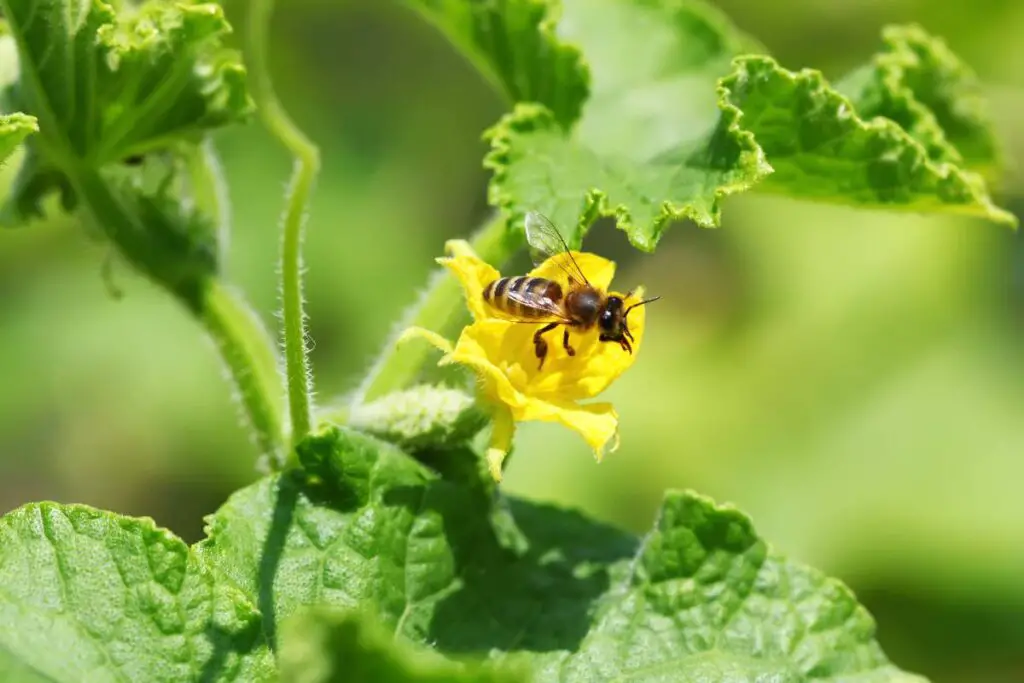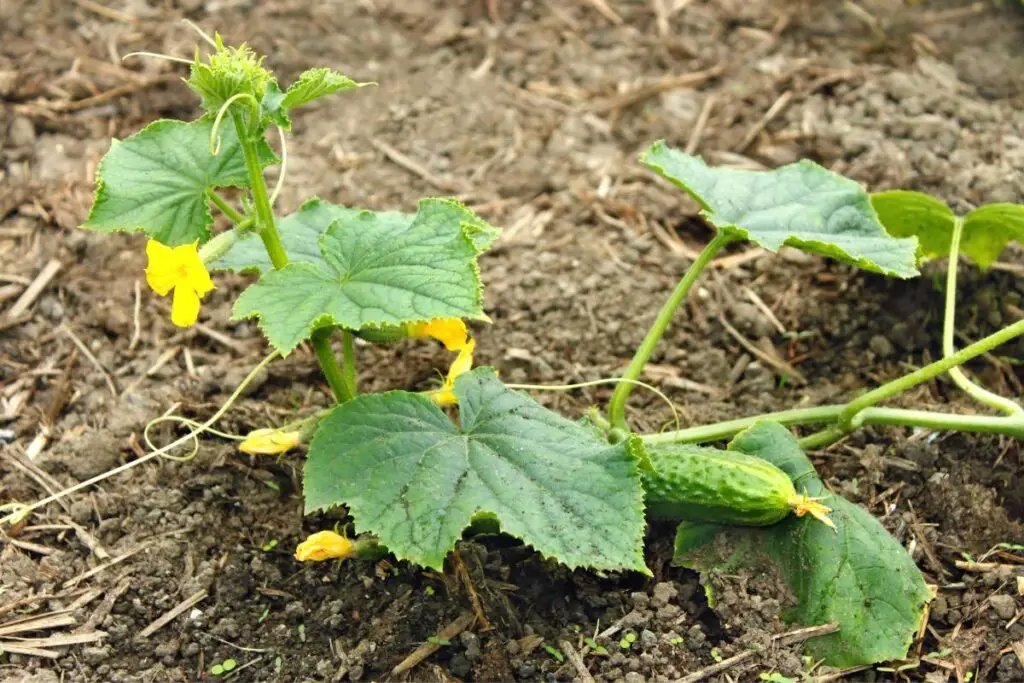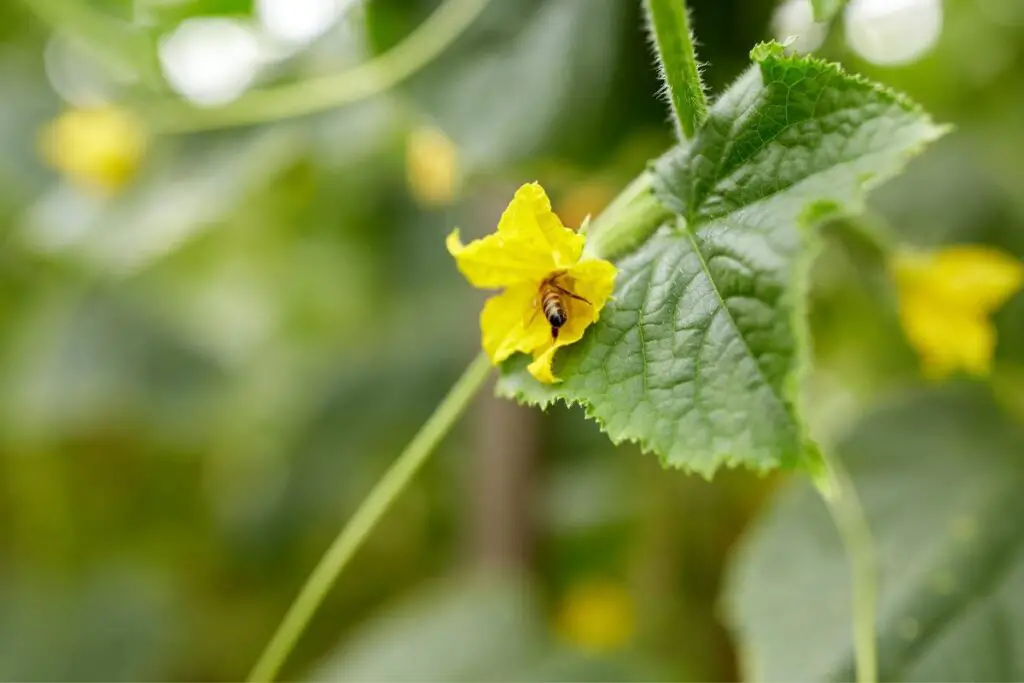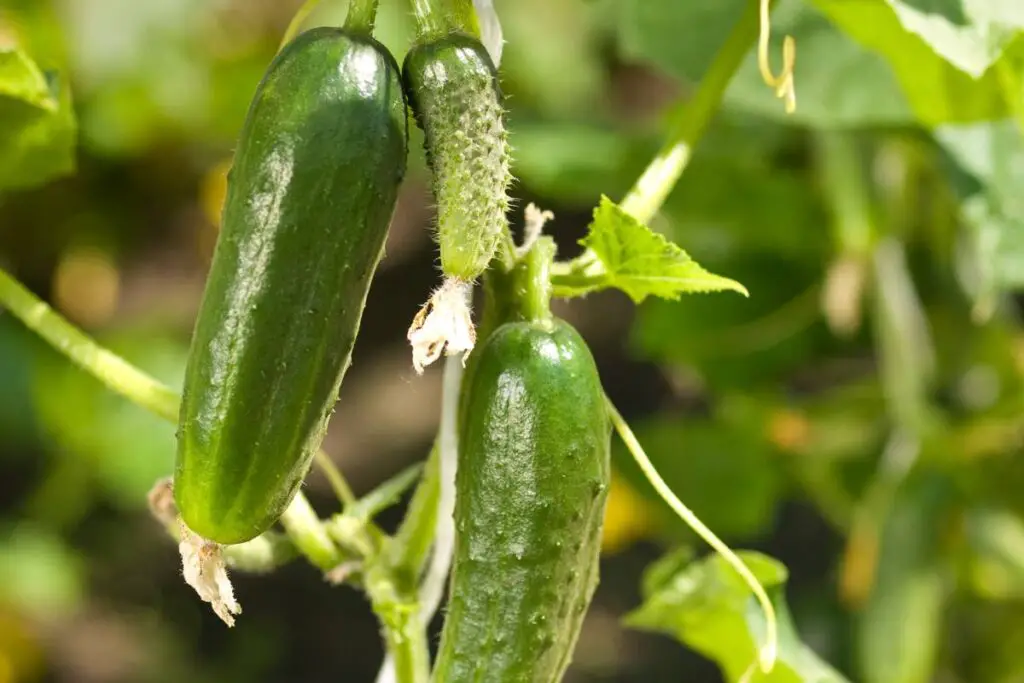Cucurbits are famous plant families, and cucumbers belong to this family. You will love to have more if you already have them in your garden. The concern of the gardeners about cucumber cross-pollination is genuine.
Cucumbers can cross-pollinate, which can occur when different varieties of cucumbers or other related plants (such as melons or squash) are grown nearby. Cross-pollination can result in seeds that produce fruit with the characteristics of both parent plants.
Cross-pollination worries you when growing cucumbers of different varieties in the same garden bed. In this article, we will examine whether cross-pollination is possible or if it is something you need to worry about.

Understanding the pollination process of the cucumber plants
Cucumbers are primarily self-pollinating plants.
They can grow both male and female flowers in the same plant.
The pollen of the male flower lands on the female flower’s ovary.
It happens through natural processes like wind and bees or other pollinators.
However, there is no guarantee that the pollinators will surely land the pollen of the male flower on the female flower’s ovary of the same plant or a different cucumber plant of the same variety.
If self-pollination does not occur, you can hand-pollinate them.
Cucumber prefers to be pollinated among the same variety or flowers of the same plant.
That is how they protect their genetic purity, and you get the true varieties with known traits.
Hand-pollination is known to give better results than self-pollination.
You can plan the pollination timing and increase the plant’s efficiency.
Here’s how to hand-pollinate them:
- Wait for the flowers to appear to identify the male and female flowers. The very first flowers are the male flowers only. The female flowers bloom after 2-3 weeks of the first male flower growth.
- Another way to identify is their growth habit. The male flowers grow in clusters of 3-5, have shorter stems, and fall off after pollination. On the contrary, the female flowers grow themselves, one per stem, and have an ovary at the center. After pollination, fruits will develop at the stem base.
- Take pollen from the fresh male flower with a cotton swab or paintbrush. Or, you can remove the stamen from the flower.
- Place the pollen in the ovary of the female flower. Be gentle because the pollen is small and sticky.
How can cucumber plants cross-pollinate with other varieties?

As I said earlier, there is no guarantee that the pollinators will drop the male flower’s pollen on the female flower of the same variety.
Sometimes, they will drop the pollen on the female flower of a different cucumber variety. That is what we call cross-pollination.
Any cucumber variety can cross-pollinate with the same cucumber species.
For instance, Marketmore 76 can cross-pollinate with the variety National or Gherkins.
If cross-pollination happens, the size and structure of the fruit would be unique, or the fruit may have the same appearance with slight differences.
The different species, for example, cucumbers and melons, won’t cross-pollinate due to incompatibility, considerable differences in genetic structure, and without lab intervention.
Is cross-pollination necessary?
Though most gardeners try to prevent cross-pollination, it is necessary in some situations.
I must have mentioned earlier that cucumbers mostly self-pollinate because they grow both male and female flowers in the same plants.
These are monoecious varieties, and most cucumbers belong to this variety.
There are exceptions, as two more cucumber varieties exist:
- Gynoecious varieties mostly grow female flowers and fewer or no male flowers. So, they need to be cross-pollinated for food production.
- Parthenocarpic varieties do not have any seeds. They grow fruits without any pollination.
As you can see, the gynoecious varieties cannot grow female flowers.
So, they need male flowers for food production.
That is when cross-pollination is necessary for them.
Factors that increase or decrease the likelihood of cucumber cross-pollination
Several factors can increase or decrease cucumber cross-pollination.
Let’s first look at the factors that can increase cross-pollination:
- The very first factor is proximity. When you plant cucumber plants close to other cucumber varieties, the chances of cross-pollination increase with the help of pollinators.
- Suppose you live in a region where the pollinator count is high. In that case, the cucumber flowers highly increase the activity of the pollinators. So, the pollinators will repeatedly visit the garden and encourage cross-pollination.
- If the weather is too windy, cross-pollination will happen naturally if different varieties are close to each other, just like self-pollination.
- If you do not want the cucumbers to cross-pollination, some factors can help decrease the cross-pollination:
- If you are growing different cucumber varieties together, consider keeping them away from each other.
- Using physical barriers to stop pollinators from visiting your garden can reduce the likelihood of cross-pollination.
- Hand-pollination is an excellent way to maintain the genetic purity of cucumbers. It is you who will be controlling the pollination.
- If you want to grow different varieties of cucumbers, consider planting them at different times. This way, you can delay the flower growth of the second variety and stop the pollinators from encouraging cross-pollination.
Effects of Cross-pollination in cucumber growth, fruit size, and taste.
Cross-pollinating the different cucumber varieties will not harm the crop. Instead, it will lead to some hybrid cucumbers.
Cross-pollination will change the newly produced cucumber’s structure, taste, and features.
There are two results of cross-pollination:
The fruit will match one of the parent varieties or be a completely different variety with a unique look and structure.
For example, the Gherkins pollinate with the Burpless to produce telegraph cucumbers.
Sometimes, the cucumbers need to cross-pollinate to crop successfully.
Cross-pollination does affect the cucumbers’ growth, fruit size, and structure, but very little.
Below are some effects you will see when cucumbers cross-pollinate:
- You will receive a completely different hybrid; these cucumbers are not guaranteed to be edible.
- In cross-pollination, the size and shape of the cucumbers will be unique and won’t match their parents. The size will be very small or huge, based on the parents’ genetic traits.
- The taste may be weird. You cannot match it with the varieties that have been cross-pollinated.
- If you need seeds of true cucumber varieties, cross-pollination is not something you should encourage.
- Even if you receive seeds from cross-pollination, they will be less uniform and predictable for the following year.
- With cross-pollination, the cucumbers’ color, shape, flavor, and everything will be completely different.
- If you cross-pollinate different cucumber varieties, you completely lose the plant’s genetic purity status.
- If you sell these cucumbers, your customers may not accept such hybrid varieties.
- Parthenocarpic varieties produce better fruits without pollination. So, cross-pollination will degrade the fruit quality.
However, I have never experienced or witnessed cross-pollination because I grew only 2 varieties far away from each other.
Since cucumbers depend on sight to attract pollinators, hand-pollination is considered the best practice.
Looking for gardening supplies? We have tested 100's of products before recommending them to you guys. Check out our best pick below:
| Image | Gardening Supplies | Best Price? |
|---|---|---|
 Top
Top Top
Top | Raised Garden Bed Kit | Check On Amazon |
 | XLUX Soil Moisture Meter, Plant Water Monitor, Soil Hygrometer Sensor for Gardening, Farming, Indoor and Outdoor Plants, No Batteries Required | No Results |
 Top
Top Top
Top | 82 Pcs Garden Tools Set and Extra Succulent Tools Set | Check On Amazon |
 | Joeys Garden Expandable Garden Hose with 8 Function Hose Nozzle, Lightweight Anti-Kink Flexible Garden Hoses, Extra Strength Fabric with Double Latex Core, (50 FT, Black) | No Results |
 Top
Top Top
Top | Dual Chamber Compost Tumbler | Check On Amazon |
 Top
Top Top
Top | Sunnyglade Plant Stakes | Check On Amazon |
 Top
Top Top
Top | Organic Cold Pressed Neem Seed Oil | Check On Amazon |
 Top
Top Top
Top | Mighty Mint Gallon :-Insect and Pest Control Peppermint Oil | Check On Amazon |
 Top
Top Top
Top | Scotts DiseaseEx Lawn Fungicide | Check On Amazon |
 Top
Top Top
Top | Jacks Classic 20-20-20 All Purpose Fertilizer | Check On Amazon |
 Top
Top Top
Top | 30,000 Seeds Pollinator Attracting Wildflower Mixture | Check On Amazon |
 Top
Top Top
Top | Survival Vegetable Seeds Garden Kit-Over 16,000 Seeds | Check On Amazon |
The importance of maintaining genetic purity in the cucumber plants

The genetic purity of cucumber plants is essential for various reasons.
With self-pollination, you will receive the exact cucumbers you have grown in your garden.
Since people grow those varieties due to their features, it is crucial to maintain purity.
However, you can still cross-pollination.
A lot of people like to know and experiment with new things.
But everyone won’t take this risk.
I do not prefer cross-pollination.
I grow Gherkins for pickles and Marketmore to enjoy them fresh and raw.
So, I don’t want them to crossbreed, receive something with unknown traits, and ultimately throw it away.
Below are some points that explain the importance of maintaining the genetic purity of cucumbers:
- Saving seeds is one of the main reasons behind the importance of maintaining genetic purity. With self-pollination, you will receive the specific cucumber seeds you want to enjoy and grow consistently.
- Some cucumbers are grown for their characteristics, like disease resistance, more extensive, sweeter, and fast growth. Genetic purity will ensure these features remain consistent and not lost due to cross-pollination.
- Some people love to analyze and study the true varieties and their genetic traits. Genetic purity ensures that the study is done without any problems. But with cross-pollination, you cannot study the variety.
- Genetic purity is vital for marketability. Customers prefer purebred cucumbers over hybrid varieties.
- The breeders put lots of time and effort into the true varieties. So, it is vital to maintain the true variety and ensure the investment is protected and worthy.
Strategies for preventing cucumber cross-pollination
If you want to have seeds and maintain the genetic purity of the cucumbers, you would want to prevent cross-pollination.
The open-pollinated varieties will have the same cucumbers every year with no cross-pollination.
Even if you grow one type of cucumber variety, the neighbor’s cucumbers may get crossed with yours by pollinators.
It is something you can’t control unless you intervene and follow strategies to stop it.
So, here are some ways to prevent cucumber cross-pollination:
- You must completely isolate the pollinators and prioritize hand pollination.
- Create barriers around the cucumbers to stop the pollinators from visiting the plants.
- Grow only one cucumber variety, such as monoecious or parthenocarpic varieties, especially in areas with high bee activities.
- If you want other varieties, find a location far away from each other. Maintain at least 1,500 meters, especially if you want true seed varieties.
- Scout for the female blossoms before they open. Hand-pollinate them with the male flowers when they open and then tape the female flowers shut after the pollination to keep the insects from further pollination.
- Growing other cucurbit families or some flowering plants around the cucumbers. These cannot cross-pollinate with the cucumbers, and additionally, the flowering plants will attract pollinators.
How to identify and remove the cross-pollinated cucumbers from the garden?
Since the cucumbers look more or less the same, identifying and removing the hybrid is difficult.
The most apparent sign of cross-pollination is the cucumber’s physical appearance.
If there has been a cross-pollination, the cucumber will be a mixture of both parent plants.
The size and shape won’t match any of your growing varieties.
Check the appearance of the cucumber varieties you are growing and the hybrid ones, and then closely examine them. You will find a bit of difference.
The cross-pollinated cucumbers will have a different, weird taste.
Try tasting the cucumber once. Don’t worry, as it won’t affect your health.
Once you have identified the cross-pollinated cucumbers, remove them from the plant.
Take a pruner. Leaving ½ to 1 inch of stem, cut and isolate the cucumber.
To prevent further cross-pollination, encourage hand-pollination, isolate the cucumber varieties from each other, or create physical barriers to stop pollinators from cross-pollinating.
Companion plants that can help to attract pollinators and reduce cross-pollination
If you do not prefer cross-pollination, grow only one cucumber variety separately or isolate them from each other.
Additionally, you would also need pollinators to get attracted to your garden for pollination.
In that case, you can grow companions that will help you in both cases.
Below are ideal companions to grow with cucumbers that will attract pollinators and stop cross-pollination:
Parsnips, carrots, and radishes
These three are root vegetables and will go well with the cucumber plants.
Their roots do not spread and compete for water and nutrients.
The cucumbers have only one taproot that goes deep, and others are shallow roots. The fruits grow above the ground.
These companions will not intrude on each other’s habitat and, thus, prevent cross-pollination.
These companions can also repel pests.
Nasturtiums and sunflowers

These flowering plants are an excellent choice for attracting insect pollinators.
Nasturtiums can deter cucumber pests like beetles, cabbage loopers, and squash bugs.
They also attract bees for pollen and nectar. So, cucumbers can benefit from this.
The Sunflowers are super-beneficial for attracting pollinators.
Another advantage you can receive from these tall flowering plants is vertical gardening.
Since the stems are tall, you can use them as a trellis and let the cucumber vines grow around them.
Both are different varieties, so there is no fear of cross-pollination.
Make sure to use lightweight cucumbers.
Melons and pumpkins
Despite belonging to the same family, these two are incompatible and won’t cross-pollinate with cucumbers.
So you can quickly grow them as companions.
Besides, they can attract bees for pollination, thus increasing the crop yield at the season’s end.
Melons also attract earthworms, which are very advantageous for soil aeration.
Benefits and drawbacks of intentionally cross-pollinating cucumber plants
Many people do not prefer cross-pollination because they wish to save seeds of the actual cucumbers only from open-pollinated cucumbers.
Cross-pollination is how new breeds are discovered. It is the next level of seed saving.
Cross-pollination produces a hybrid cucumber whose features and genetic traits differ entirely from its parents.
It can be exciting for gardeners who want to experiment.
But it is a drawback for those who want seeds that are true to the type.
When gardeners are curious about the result of cross-pollination, they either allow the pollinators to cross-pollinate by growing different varieties close to each other or do it intentionally by hand-pollination.
Below I have shared some merits and demerits of intentional cross-pollination.
These can vary from person to person, as most are my opinions.
Benefits
- You will get a unique cucumber from cross-pollination. It is beneficial for gardeners who want to examine and study the genetic features of the hybrid variety in detail.
- If your cucumber plants are gynoecious, then your plants can benefit from cross-pollination.
- In some cases, cross-pollination can encourage cucumbers to crop successfully.
- Cucumbers from cross-pollination can be much healthier than the others. They will have new genetic traits which can make them more resistant to diseases than their parents.
- Since their physical appearance will differ, the garden bed could be the center of attraction.
- It is ideal for plant breeders to increase genetic diversity.
Drawbacks
- You will despise cross-pollination if you want to save seeds to grow the true cucumber variety. With this process, you lose the specific variety.
- With cross-pollination, you cannot receive enough seeds for the next growing season.
- Even if you receive the seeds, they will be unstable and unpredictable.
- The hybrid cucumbers will not match their parents and will have some genetic traits you will be unaware of. In that case, you have to remove them.
- The genetic purity of the cucumbers is lost with cross-pollination.
- If you are selling cucumbers, your customers will not accept these crossbreeds.
Tips for encouraging cross-pollination and selecting the suitable cucumber varieties for it

As I said before, some gardeners, especially in the greenhouses, want to cross-pollinate the cucumbers simply out of curiosity.
They want to study the traits of hybrid cucumbers and discover new varieties.
Another situation where cross-pollination is preferred is for the gynoecious cucumbers.
These cucumbers grow only female flowers with no male flowers, without which pollination is impossible.
Sometimes, they grow a few male flowers, but that does not guarantee or increase the chances of pollination.
Some gynoecious varieties are:
- Bristol
- Citadel
- Olympian
You will need another cucumber variety for pollination if you have any of these varieties.
In that case, the best choice should be the monoecious cucumbers.
Monoecious cucumbers grow both male and female flowers in abundance.
So, you can allow cross-pollination among the monoecious and gynoecious varieties for fruit growth in the latter.
Parthenocarpic varieties have no seeds, and they produce without pollination.
When the pollinators carry the pollen from the male flowers and drop it to the female flowers of the gynoecious varieties, they can procreate.
Some ideal monoecious cucumbers for cross-pollinating with the gynoecious varieties are:
- Itachi
- Lemon
- Marketmore 76
- Stripped Armenian
My local gardener once told me that these could help in cross-pollination for gynoecious plants, so I thought of sharing them with you.
For confirmation, ask your local gardener. Some companies sell seed packets containing a few monoecious varieties with gynoecious varieties.
Check Johnny’s Selected Seeds once. I have heard they sell such packets.
Another way is to spray blossom set sprays for pollinating the cucumbers.
The spray provides a Kinetin hormone that encourages the cucumber blooms to produce fruit without pollination.
Final words
Cucumbers produce fruits by self-pollination, but they will also cross-pollinate. The pollen from the male flower will be dropped in the female flower’s stigma of the same plant or different plants of the same variety by natural means like pollinators and wind. If the male flower’s pollen gets dropped to the female flower’s stigma of a different variety, it will lead to cross-pollination.
If cross-pollination occurs, the fruit will be a hybrid one, and it will be completely different from its parents physically and genetically. It might benefit greenhouse gardeners who want to study but not gardeners who want pure varieties.
Since house gardeners grow a specific variety for a reason, they don’t want to compromise with it. However, cross-pollination is necessary for gynoecious varieties as they do not have any male flowers. In that case, plant the monoecious varieties to help the gynoecious varieties produce fruits.
To save seeds of true cucumber varieties, prevent cross-pollination by isolating the varieties from each other, creating barriers to prevent pollinators from reaching the flowers, and approaching hand-pollination.
Companions that can prevent cross-pollination and attract pollinators are carrots, parsnips, radishes, melons, pumpkins, nasturtiums, and sunflowers.
Will cucumbers cross-pollinate with other cucurbit species?
Despite belonging to the same family, the cucumbers won’t cross-pollinate with the other cucurbit species. Even if the bees carry the cucumber’s pollen to the other species, there won’t be any production because their pollen is incompatible.
Is it true that Armenian varieties can cross-pollinate with other cucurbit species?
Only Armenian cucumbers are known to cross-pollinate with cantaloupes because the Armenian variety is not an actual cucumber but a melon instead. It grows like cucumbers and is harvested young.
Reference: Cucumber Flowering and Pollination Wikipedia
